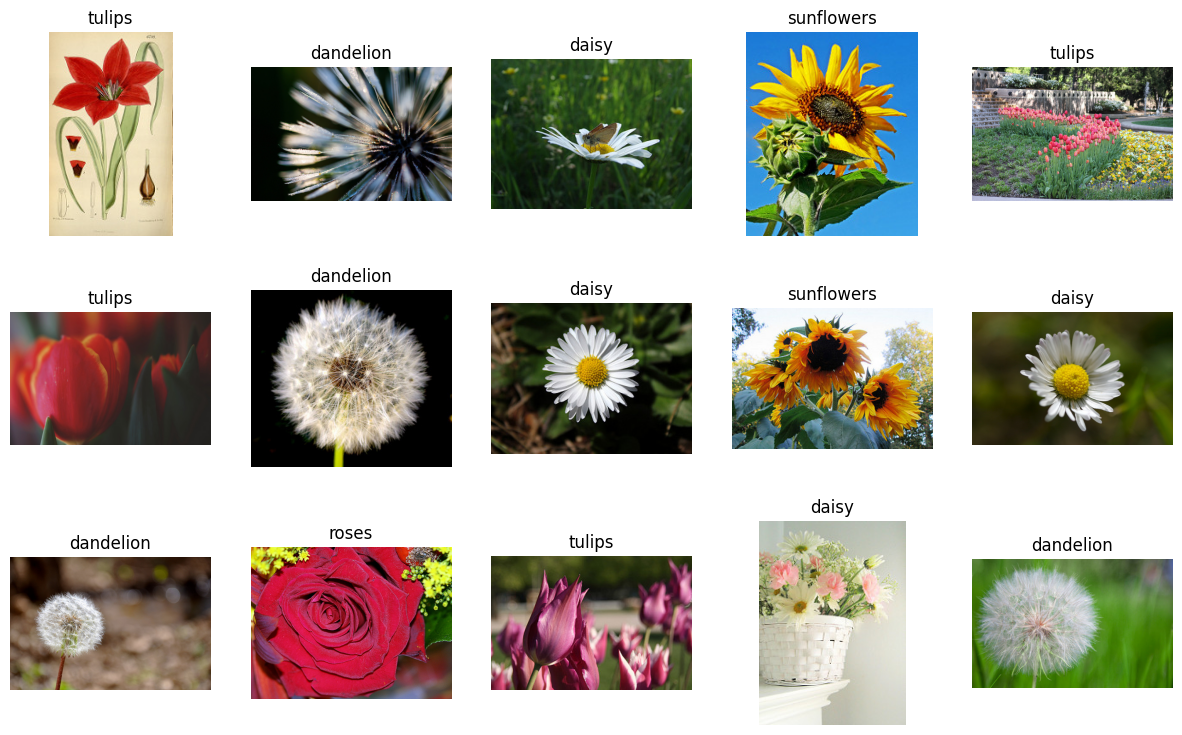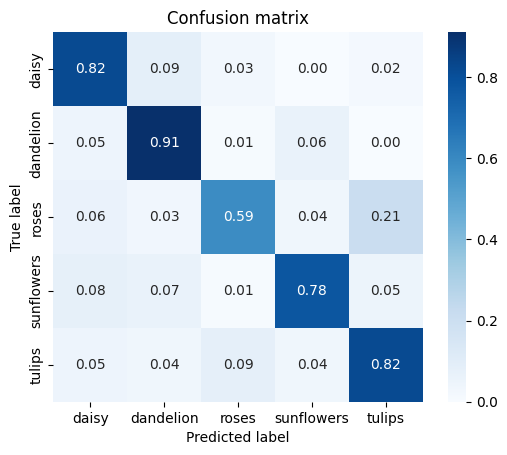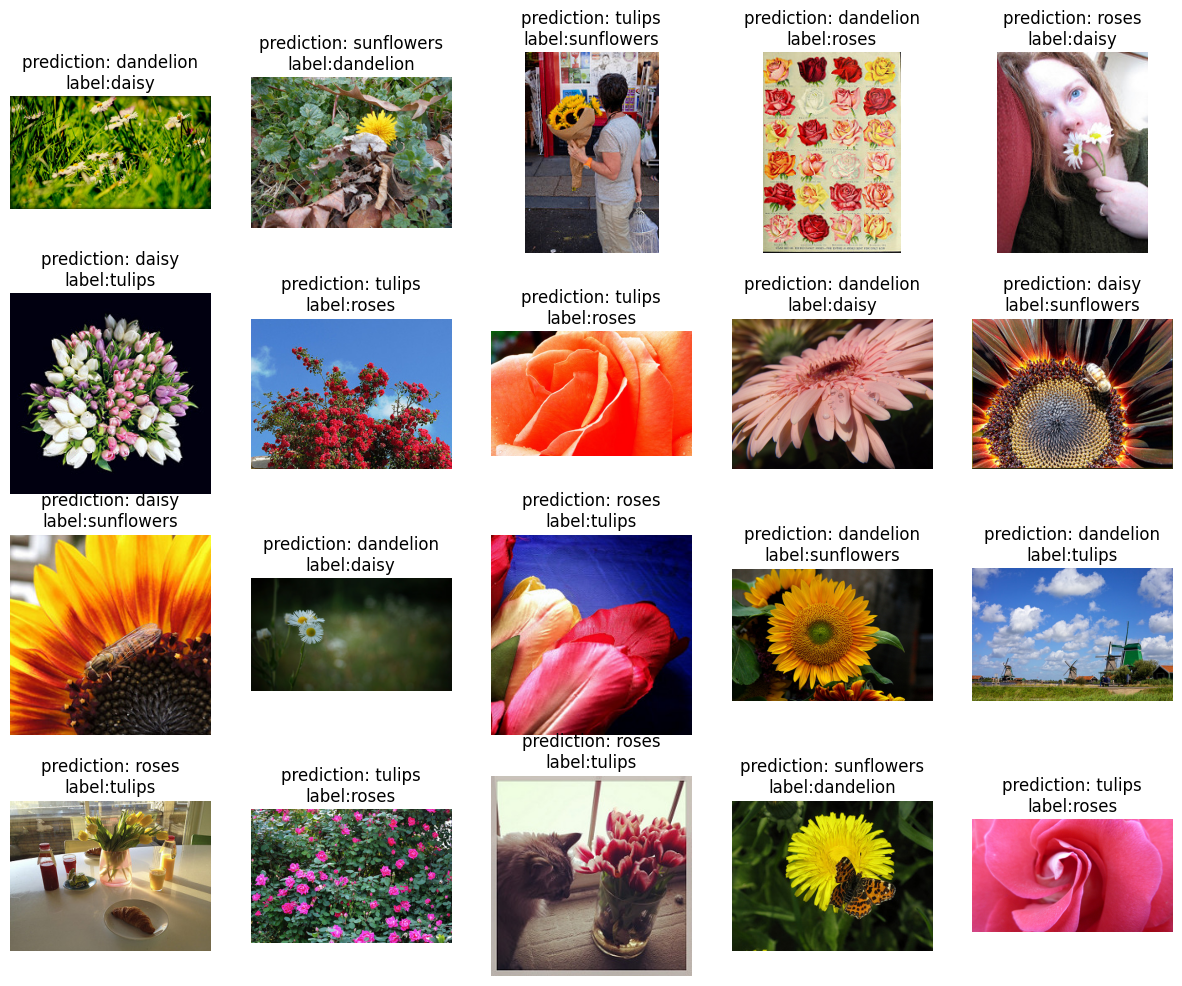 View 在 TensorFlow.org 上查看 View 在 TensorFlow.org 上查看 |
 在 Google Colab 中运行 在 Google Colab 中运行 |
 在 GitHub 中查看源代码 在 GitHub 中查看源代码 |
 下载笔记本 下载笔记本 |
 查看 TF Hub 模型 查看 TF Hub 模型 |
您是否曾看到某种漂亮的花,却不知道它是哪种花?有过类似经历的不止您一个人,那么我们来构建一种能够通过照片识别花卉种类的方法吧!
事实证明,一种称为卷积神经网络的特殊类型的深度神经网络在图像分类方面特别强大。但是,现代卷积神经网络具有数百万个参数。从头开始训练它们需要大量带有标签的训练数据和大量计算能力(数百个 GPU 小时或更长时间)。我们只有大约三千张带有标签的照片,并且想花更少的时间,因此我们需要更加聪明的做法。
我们将使用一种名为迁移学习的技术,通过该技术,我们会获得一个经过预训练的网络(在大约一百万个普通图像上进行训练),用它来提取特征,并在顶部为我们的花卉分类任务训练一个新层。
设置
import collections
import io
import math
import os
import random
from six.moves import urllib
from IPython.display import clear_output, Image, display, HTML
import tensorflow.compat.v1 as tf
tf.disable_v2_behavior()
import tensorflow_hub as hub
import numpy as np
import matplotlib.pyplot as plt
import seaborn as sns
import sklearn.metrics as sk_metrics
import time
2022-12-14 20:25:05.224370: W tensorflow/compiler/xla/stream_executor/platform/default/dso_loader.cc:64] Could not load dynamic library 'libnvinfer.so.7'; dlerror: libnvinfer.so.7: cannot open shared object file: No such file or directory 2022-12-14 20:25:05.224463: W tensorflow/compiler/xla/stream_executor/platform/default/dso_loader.cc:64] Could not load dynamic library 'libnvinfer_plugin.so.7'; dlerror: libnvinfer_plugin.so.7: cannot open shared object file: No such file or directory 2022-12-14 20:25:05.224472: W tensorflow/compiler/tf2tensorrt/utils/py_utils.cc:38] TF-TRT Warning: Cannot dlopen some TensorRT libraries. If you would like to use Nvidia GPU with TensorRT, please make sure the missing libraries mentioned above are installed properly. WARNING:tensorflow:From /tmpfs/src/tf_docs_env/lib/python3.9/site-packages/tensorflow/python/compat/v2_compat.py:107: disable_resource_variables (from tensorflow.python.ops.variable_scope) is deprecated and will be removed in a future version. Instructions for updating: non-resource variables are not supported in the long term
花卉数据集
花卉数据集由具有 5 个可能的类标签的花卉图像组成。
我们在训练机器学习模型时,将数据拆分为训练数据集和测试数据集。我们将用训练数据训练模型,然后用模型从未见过的数据(测试集)评估其性能。
我们来下载训练和测试样本(可能需要花一些时间),并将其拆分为训练集和测试集。
运行下面两个单元中的代码:
FLOWERS_DIR = './flower_photos'
TRAIN_FRACTION = 0.8
RANDOM_SEED = 2018
def download_images():
"""If the images aren't already downloaded, save them to FLOWERS_DIR."""
if not os.path.exists(FLOWERS_DIR):
DOWNLOAD_URL = 'http://download.tensorflow.org/example_images/flower_photos.tgz'
print('Downloading flower images from %s...' % DOWNLOAD_URL)
urllib.request.urlretrieve(DOWNLOAD_URL, 'flower_photos.tgz')
!tar xfz flower_photos.tgz
print('Flower photos are located in %s' % FLOWERS_DIR)
def make_train_and_test_sets():
"""Split the data into train and test sets and get the label classes."""
train_examples, test_examples = [], []
shuffler = random.Random(RANDOM_SEED)
is_root = True
for (dirname, subdirs, filenames) in tf.gfile.Walk(FLOWERS_DIR):
# The root directory gives us the classes
if is_root:
subdirs = sorted(subdirs)
classes = collections.OrderedDict(enumerate(subdirs))
label_to_class = dict([(x, i) for i, x in enumerate(subdirs)])
is_root = False
# The sub directories give us the image files for training.
else:
filenames.sort()
shuffler.shuffle(filenames)
full_filenames = [os.path.join(dirname, f) for f in filenames]
label = dirname.split('/')[-1]
label_class = label_to_class[label]
# An example is the image file and it's label class.
examples = list(zip(full_filenames, [label_class] * len(filenames)))
num_train = int(len(filenames) * TRAIN_FRACTION)
train_examples.extend(examples[:num_train])
test_examples.extend(examples[num_train:])
shuffler.shuffle(train_examples)
shuffler.shuffle(test_examples)
return train_examples, test_examples, classes
# Download the images and split the images into train and test sets.
download_images()
TRAIN_EXAMPLES, TEST_EXAMPLES, CLASSES = make_train_and_test_sets()
NUM_CLASSES = len(CLASSES)
print('\nThe dataset has %d label classes: %s' % (NUM_CLASSES, CLASSES.values()))
print('There are %d training images' % len(TRAIN_EXAMPLES))
print('there are %d test images' % len(TEST_EXAMPLES))
Downloading flower images from http://download.tensorflow.org/example_images/flower_photos.tgz... Flower photos are located in ./flower_photos The dataset has 5 label classes: odict_values(['daisy', 'dandelion', 'roses', 'sunflowers', 'tulips']) There are 2934 training images there are 736 test images
探索数据
花卉数据集由样本(带标签的花卉图像)组成。每个样本均包含一个 JPEG 花卉图像和类标签(即花卉的类型)。我们来显示一些图像及其标签。
Show some labeled images
def get_label(example):
"""Get the label (number) for given example."""
return example[1]
def get_class(example):
"""Get the class (string) of given example."""
return CLASSES[get_label(example)]
def get_encoded_image(example):
"""Get the image data (encoded jpg) of given example."""
image_path = example[0]
return tf.gfile.GFile(image_path, 'rb').read()
def get_image(example):
"""Get image as np.array of pixels for given example."""
return plt.imread(io.BytesIO(get_encoded_image(example)), format='jpg')
def display_images(images_and_classes, cols=5):
"""Display given images and their labels in a grid."""
rows = int(math.ceil(len(images_and_classes) / cols))
fig = plt.figure()
fig.set_size_inches(cols * 3, rows * 3)
for i, (image, flower_class) in enumerate(images_and_classes):
plt.subplot(rows, cols, i + 1)
plt.axis('off')
plt.imshow(image)
plt.title(flower_class)
NUM_IMAGES = 15
display_images([(get_image(example), get_class(example))
for example in TRAIN_EXAMPLES[:NUM_IMAGES]])

构建模型
我们将加载 TF-Hub 图像特征向量模块,在它上面堆叠一个线性分类器,并添加训练和评估运算。以下单元将构建一个描述模型及其训练的 TF 计算图,但不会运行训练(这是下一个步骤)。
LEARNING_RATE = 0.01
tf.reset_default_graph()
# Load a pre-trained TF-Hub module for extracting features from images. We've
# chosen this particular module for speed, but many other choices are available.
image_module = hub.Module('https://tfhub.dev/google/imagenet/mobilenet_v2_035_128/feature_vector/2')
# Preprocessing images into tensors with size expected by the image module.
encoded_images = tf.placeholder(tf.string, shape=[None])
image_size = hub.get_expected_image_size(image_module)
def decode_and_resize_image(encoded):
decoded = tf.image.decode_jpeg(encoded, channels=3)
decoded = tf.image.convert_image_dtype(decoded, tf.float32)
return tf.image.resize_images(decoded, image_size)
batch_images = tf.map_fn(decode_and_resize_image, encoded_images, dtype=tf.float32)
# The image module can be applied as a function to extract feature vectors for a
# batch of images.
features = image_module(batch_images)
def create_model(features):
"""Build a model for classification from extracted features."""
# Currently, the model is just a single linear layer. You can try to add
# another layer, but be careful... two linear layers (when activation=None)
# are equivalent to a single linear layer. You can create a nonlinear layer
# like this:
# layer = tf.layers.dense(inputs=..., units=..., activation=tf.nn.relu)
layer = tf.layers.dense(inputs=features, units=NUM_CLASSES, activation=None)
return layer
# For each class (kind of flower), the model outputs some real number as a score
# how much the input resembles this class. This vector of numbers is often
# called the "logits".
logits = create_model(features)
labels = tf.placeholder(tf.float32, [None, NUM_CLASSES])
# Mathematically, a good way to measure how much the predicted probabilities
# diverge from the truth is the "cross-entropy" between the two probability
# distributions. For numerical stability, this is best done directly from the
# logits, not the probabilities extracted from them.
cross_entropy = tf.nn.softmax_cross_entropy_with_logits_v2(logits=logits, labels=labels)
cross_entropy_mean = tf.reduce_mean(cross_entropy)
# Let's add an optimizer so we can train the network.
optimizer = tf.train.GradientDescentOptimizer(learning_rate=LEARNING_RATE)
train_op = optimizer.minimize(loss=cross_entropy_mean)
# The "softmax" function transforms the logits vector into a vector of
# probabilities: non-negative numbers that sum up to one, and the i-th number
# says how likely the input comes from class i.
probabilities = tf.nn.softmax(logits)
# We choose the highest one as the predicted class.
prediction = tf.argmax(probabilities, 1)
correct_prediction = tf.equal(prediction, tf.argmax(labels, 1))
# The accuracy will allow us to eval on our test set.
accuracy = tf.reduce_mean(tf.cast(correct_prediction, tf.float32))
WARNING:tensorflow:From /tmpfs/tmp/ipykernel_17023/2879154528.py:20: calling map_fn (from tensorflow.python.ops.map_fn) with dtype is deprecated and will be removed in a future version. Instructions for updating: Use fn_output_signature instead WARNING:tensorflow:From /tmpfs/tmp/ipykernel_17023/2879154528.py:20: calling map_fn (from tensorflow.python.ops.map_fn) with dtype is deprecated and will be removed in a future version. Instructions for updating: Use fn_output_signature instead INFO:tensorflow:Saver not created because there are no variables in the graph to restore INFO:tensorflow:Saver not created because there are no variables in the graph to restore /tmpfs/tmp/ipykernel_17023/2879154528.py:34: UserWarning: `tf.layers.dense` is deprecated and will be removed in a future version. Please use `tf.keras.layers.Dense` instead. layer = tf.layers.dense(inputs=features, units=NUM_CLASSES, activation=None)
训练网络
现在,模型已经构建,我们来对它进行训练,并查看它在测试集上的性能。
# How long will we train the network (number of batches).
NUM_TRAIN_STEPS = 100
# How many training examples we use in each step.
TRAIN_BATCH_SIZE = 10
# How often to evaluate the model performance.
EVAL_EVERY = 10
def get_batch(batch_size=None, test=False):
"""Get a random batch of examples."""
examples = TEST_EXAMPLES if test else TRAIN_EXAMPLES
batch_examples = random.sample(examples, batch_size) if batch_size else examples
return batch_examples
def get_images_and_labels(batch_examples):
images = [get_encoded_image(e) for e in batch_examples]
one_hot_labels = [get_label_one_hot(e) for e in batch_examples]
return images, one_hot_labels
def get_label_one_hot(example):
"""Get the one hot encoding vector for the example."""
one_hot_vector = np.zeros(NUM_CLASSES)
np.put(one_hot_vector, get_label(example), 1)
return one_hot_vector
with tf.Session() as sess:
sess.run(tf.global_variables_initializer())
for i in range(NUM_TRAIN_STEPS):
# Get a random batch of training examples.
train_batch = get_batch(batch_size=TRAIN_BATCH_SIZE)
batch_images, batch_labels = get_images_and_labels(train_batch)
# Run the train_op to train the model.
train_loss, _, train_accuracy = sess.run(
[cross_entropy_mean, train_op, accuracy],
feed_dict={encoded_images: batch_images, labels: batch_labels})
is_final_step = (i == (NUM_TRAIN_STEPS - 1))
if i % EVAL_EVERY == 0 or is_final_step:
# Get a batch of test examples.
test_batch = get_batch(batch_size=None, test=True)
batch_images, batch_labels = get_images_and_labels(test_batch)
# Evaluate how well our model performs on the test set.
test_loss, test_accuracy, test_prediction, correct_predicate = sess.run(
[cross_entropy_mean, accuracy, prediction, correct_prediction],
feed_dict={encoded_images: batch_images, labels: batch_labels})
print('Test accuracy at step %s: %.2f%%' % (i, (test_accuracy * 100)))
Test accuracy at step 0: 26.36% Test accuracy at step 10: 50.14% Test accuracy at step 20: 65.62% Test accuracy at step 30: 68.34% Test accuracy at step 40: 73.78% Test accuracy at step 50: 77.17% Test accuracy at step 60: 77.31% Test accuracy at step 70: 77.31% Test accuracy at step 80: 79.21% Test accuracy at step 90: 80.71% Test accuracy at step 99: 79.35%
def show_confusion_matrix(test_labels, predictions):
"""Compute confusion matrix and normalize."""
confusion = sk_metrics.confusion_matrix(
np.argmax(test_labels, axis=1), predictions)
confusion_normalized = confusion.astype("float") / confusion.sum(axis=1)
axis_labels = list(CLASSES.values())
ax = sns.heatmap(
confusion_normalized, xticklabels=axis_labels, yticklabels=axis_labels,
cmap='Blues', annot=True, fmt='.2f', square=True)
plt.title("Confusion matrix")
plt.ylabel("True label")
plt.xlabel("Predicted label")
show_confusion_matrix(batch_labels, test_prediction)

错误的预测
让我们仔细看看模型预测出错的测试样本。
- 测试集中是否有标签错误的样本?
- 测试集中是否有不良数据(即图像实际上不是花卉图片)?
- 是否存在能够让您理解模型出错原因的图像?
incorrect = [
(example, CLASSES[prediction])
for example, prediction, is_correct in zip(test_batch, test_prediction, correct_predicate)
if not is_correct
]
display_images(
[(get_image(example), "prediction: {0}\nlabel:{1}".format(incorrect_prediction, get_class(example)))
for (example, incorrect_prediction) in incorrect[:20]])

练习:改进模型!
我们已经训练了一个基础模型,现在我们来尝试对它进行改进,以实现更好的准确率。(请记住,更改后需要重新运行代码单元。)
练习 1:尝试不同的图像模型。
使用 TF-Hub,尝试几种不同的图像模型非常简单。只需将 hub.Module() 调用中的 "https://tfhub.dev/google/imagenet/mobilenet_v2_050_128/feature_vector/2" 句柄替换为其他模块的句柄,然后重新运行所有代码即可。您可以在 tfhub.dev 上查看所有可用的图像模块。
其他 MobileNet V2 模块可能会是不错的选择。许多模块(包括 MobileNet 模块)都在 ImageNet 数据集上进行了训练,该数据集包含超过一百万个图像和 1000 个类。选择网络架构需要在速度和分类准确率之间进行权衡:像 MobileNet 或 NASNet Mobile 这样的模型既快又小,而更传统的架构(如 Inception 和 ResNet)则为准确率而设计。
对于较大的 Inception V3 架构,您还可以探索在更接近您的任务的域上进行预训练的好处:它还可以作为已在 iNaturalist 动植物数据集上训练的模块进行提供。
练习 2:添加隐藏层。
在提取的图像特征和线性分类器之间堆叠一个隐藏层(在上述 create_model() 函数中)。例如,要用 100 个节点创建一个非线性隐藏层,请使用 tf.layers.dense(将单元设置为 100,并将激活设置为 tf.nn.relu)。更改隐藏层的大小是否会影响测试准确率?添加第二个隐藏层是否会提高准确率?
练习 3:更改超参数。
增加训练步骤的数量是否能够提高最终的准确率?是否可以通过更改学习率使模型更快收敛?训练批次大小是否会影响模型的性能?
练习 4:尝试不同的优化器。
用更复杂的优化器(例如 AdagradOptimizer)替换基本的 GradientDescentOptimizer。这是否会对您的模型训练产生影响?如果您想详细了解不同优化算法的优势,请阅读这篇博文。
了解更多信息
如果您对本教程的更高级版本有兴趣,请查看 TensorFlow 图像重新训练教程,该教程将引导您使用 TensorBoard 对训练进行可视化,介绍高级技术(如通过扭曲图像进行数据集扩充),以及将花卉数据集替换为您自己的数据集供图像分类器进行学习。
您可以在 tensorflow.org 上详细了解 TensorFlow,并在 tensorflow.org/hub 上查看 TF-Hub API 文档。还可以在 tfhub.dev 上找到可用的 TensorFlow Hub 模块,包括更多图像特征向量模块和文本嵌入向量模块。
另外,请查看机器学习速成课程,这是 Google 提供的针对机器学习的快节奏实用介绍。
